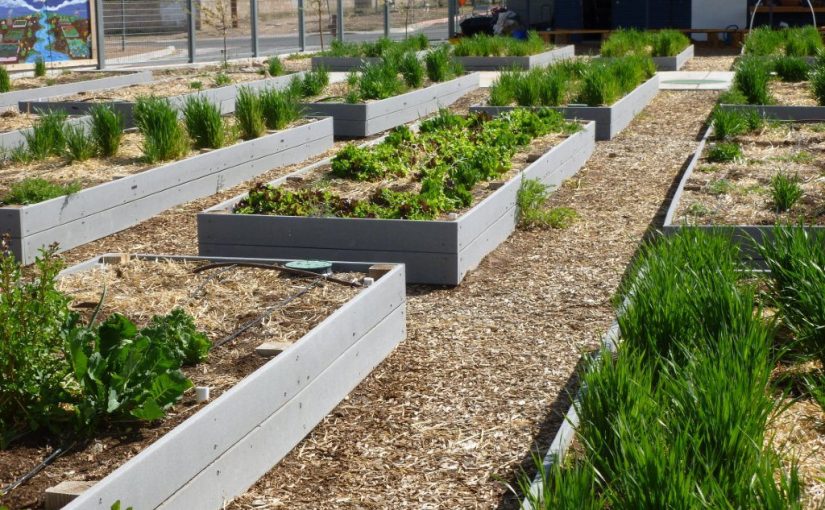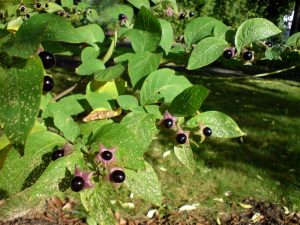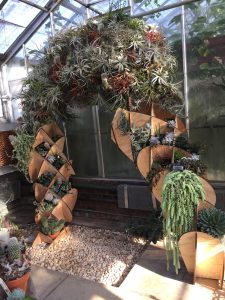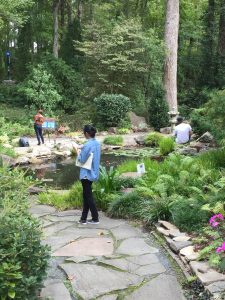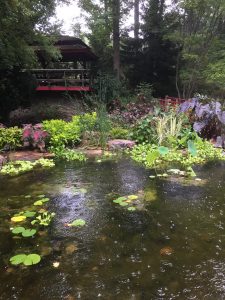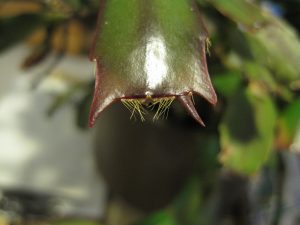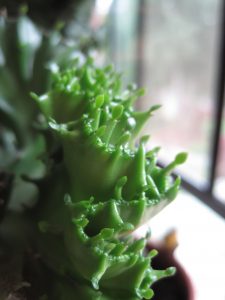One of the things I miss (and sometimes don’t miss) after my move from West Virginia to Nebraska is writing my weekly garden column for the Charleston Gazette-Mail newspaper. It was a great way to always keep thinking about new things to talk about and a great way to connect with the public.
After I left, the newspaper replaced me with a team of 4-5 local gardeners who would take turns writing about their different gardening insights and experiences. Some have been really good, like the ones who were my former Master Gardener volunteers. However, sometimes I find the bad information and attitude of one of the writers off-putting and even angering.
Take for example this missive which equates sustainable agriculture (a term which is pretty well defined as a balance of environmental stewardship, profit, and quality of life) solely to permaculture and biodiversity while espousing an elitist attitude about “no pesticides, no fossil fuels, no factory farms, growing all you need locally and enhancing the land’s fertility while you’re at it.” He got all this from an old photo of dirt poor farmers who were apparently practicing “permaculture” – which I’m sure was foremost on their minds while they were trying not to starve to death. The fact is that our food system (and the food that today’s low income families) depends on comes from a mix of small and large farms. And most of those “factory farms” are actually family owned, and not everyone can afford to grow their own food or pay the premium for organic food (which still has been treated with pesticides and is in no way better or healthier than those conventionally grown).
Now, I know I no longer have a dog in that fight, but when I see bad information, especially when it is aimed toward an audience that I care deeply about I just have to correct it. So two weeks ago when I saw his latest gem of an article berating a woman (and basically anyone) for using lumber (and those who work as big box store shills to promote them) to build raised bed gardens and should instead till up large portions of their yard for the garden I was aghast. Putting aside the horrible advice to till up the garden (which we’ll talk about in a minute) or the outdated recommendation of double digging (proven to have no benefit), that advice is just full of elitist assumptions toward both the gardener and toward the technique. It is especially ridiculous and ill-informed to suggest that tilling up a garden and destroying the soil structure is much better ecologically speaking that using a raised bed (and we’ll talk about why in a little bit).
Don’t want to do a raised bed? Fine, it isn’t for everyone. But that doesn’t mean you should go out and till up a large patch of land that will degrade the soil, lead to erosion and runoff, and reduce production. It does not do anything to improve drainage nor aeration.
So let’s do a breakdown of why I find this article, its assumptions, and bad science so distasteful:
Bad Assumptions (and you know what they say about assuming)
The gardener didn’t have a reason for a raised bed other than she had been told that’s the way you do it.
This assumption fails to take into account the many different reasons why a gardener may prefer to use a raised bed. Does she or a family member have mobility limitations where a raised bed would provide access to be able to garden? Or does she have space limitations for a large garden patch? Would a raised bed make it easier for her to manage and maintain the garden? Making a blanket pronouncement against the technique fails to use empathy to see if it actually would make gardening more accessible or successful for the gardener. Is she wanting a raised bed because the soil in the ground at her house is too poor or contaminated? West Virginia is notorious for having heavy clay, rocky soil that is pretty poor for growing most crops. It can take years of amending to get it even halfway acceptable for gardening. Or perhaps she lives on a lot that had some sort of soil contamination in the past and she’s using raised beds to avoid contact with the contaminated soil.
Raised beds also have some production advantages – the soil heats up faster in the spring, allowing for earlier planting. A well-built soil also allows for improved drainage in areas with heavy soil or excess moisture.
The gardener has access to equipment to till up a garden space, have the physical strength and endurance to hand dig it, or is she able to afford to pay someone to do it for her?
Raised beds can often be easier for gardeners to build and maintain, often not needing special equipment or heavy labor. If the gardener isn’t supposed to benefit from these efficiencies, how will she go about tilling up the soil for her new garden. Does she or a friend/neighbor have a rototiller or tractor she can use? Is she physically capable of the often back-breaking work of turning the soil by hand? Or does she have money to pay someone to do it for her? So these “cheaper and easier” methods he describes could actually end up costing more and being harder than building a raised bed.
The raised bed has to be built out of lumber, which apparently only comes from the Pacific Northwest and is a horrible thing to buy. First off, raised beds can be built out of a number of materials. The list usually starts with lumber. Some people tell you to use cedar (which does primarily come from the PNW), since it is more resistant to decay, but plain pine that’s treated with a protective oil or even pressure treated is fine (it used to be not OK back before the turn of the century when it was treated with arsenic, but most experts now say it is OK since it is treated with copper). The dig against the PNW lumber industry is as confusing as it is insulting, since there’s lots of lumber produced on the east coast, and even a thriving timber industry right in West Virginia. Most lumber these days is harvested from tree farms specifically planted for the purpose or by selective timbering that helps manage forest land for tree health and sustainability.
The list can go on to include landscaping stone, concrete blocks, found materials like tree branches, and on and on. These days, you can even buy simple kits you can put together without tools and with minimal effort that are made of high-grade plastic or composite lumber. They’re getting cheaper every year, and can be especially affordable if you find a good sale or coupon.
Heck, a raised bed doesn’t even require the use of a frame at all….just a mound of well amended soil in a bed shape will do. No need to disturb the soil underneath, just get some good topsoil/garden soil in bulk or bags from your favorite garden center, mix it with a little good compost, and layer at least 6 inches on top of the soil. Use a heavy mulch on top if you are afraid of weeds coming up through the new soil.
The soil she’d buy is trucked in from Canada.
I’m guessing this has some sort of assumption that the soil a gardener should be putting a raised bed is like a potting mix composed primarily of peat moss. While many gardeners are trying to decrease the use of peat moss, which is a non-renewable resource harvested from Canadian peat bogs, the recommended soil for a raised bed is not potting mix or one that even contains a large amount of organic material. The recommended composition of raised bed soil is largely good quality top soil, which is usually sourced locally, mixed with a bit of compost which could be from home compost, a local municipal composting facility or producer, or from a bagged commercial product that is likely from a company that diverts municipal, agricultural, and food wastes into their product.
Bad Advice based on Bad Science (or lack thereof)
Tilling or disturbing the soil is a common and acceptable way to prepare a garden.
More and more evidence is emerging that tilling or disturbing the soil is actually one of the worst things you can do in terms of both production and environmental impact in agricultural production. First, tilling disturbs and in some cases destroys the soil structure. Destroying the soil structure allows for increased erosion, especially when the bare soil is washed away during heavy rains or blown away in heavy winds. Excess tillage and wind is what actually led to the dust bowl, which actually led to the early promotion of conservation tillage practices through government programs like Conservation Districts (and also gave us some great literature, thanks to John Steinbeck). Aside from the soil particles that erode, having open, tilled soil leads to nutrient runoff that contribute to water pollution.
One other structure negative is the production of a hardpan or compressed layer of soil that occurs just below the tilled area. This results from the tines of a tiller or cultivator pressing down on the soil at the bottom of where it tills and can drastically reduce the permeation of water and gasses through the soil.
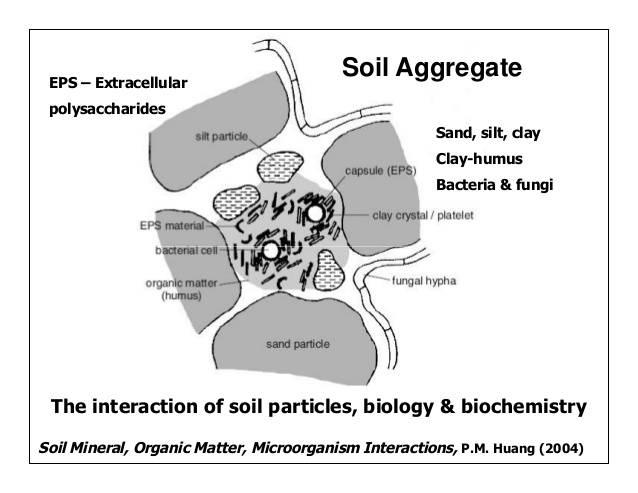
The aggregates in the structure of un-disturbed soil provide myriad benefits to soil health, especially in providing the capacity for the growth of good microorganisms. Studies have shown that the population of soil microbes is drastically higher in agricultural soils that haven’t been tilled. Therefore, tillage reduces soil biodiversity.
One of the reasons for increased soils microbes in no-till soil is an increase in soil organic matter. No-till allows for some crop (roots, etc) to remain in the ground and break down. Tillage also incorporates more air into the soil, which does the same thing that turning a compost pile does – it allows the decomposition microbes to work faster in breaking down organic matter. This increased activity then decreases the amount of organic matter. So tilling the soil actually reduces organic matter. The structure and organic matter also allows no-till soil to have a higher Cation Exchange Capacity, or ability to hold nutrients.
When the carbon in the organic matter in the soil is rapidly depleted after tillage, it doesn’t just disappear. The product of the respiration from all those bacteria and fungi is the same as it is for all living creatures – carbon dioxide. The organic matter held in the soil therefore provides a great service (we call this an ecosystem service) in that it sequesters carbon from the environment. This can help mitigate climate change and even effect global food security.

Double digging does a garden good.
Look through many-a garden book and it will tell you to start a garden bed by double digging, which is a term used to describe a back breaking procedure where you remove the top layer of soil, then disturb a layer beneath it and mix up the layers. While it may not be as drastic as running a tiller or tractor through the soil, it still destroys the structure with the same negative outcomes as above. Additionally, while many gardeners swear by it, there is evidence that the only benefit to come from it is to prove to yourself and others that you can do hard work. It has no benefit for the garden and usually negative effects on the soul, psyche, and back of the gardener.
Large tilled up gardens are easier to maintain. One of the benefits of gardening in a bed, raised or otherwise, is that the close spacing allows you to grow more stuff in a smaller area. By reducing the area under production, you also reduce the labor and the inputs (compost, fertilizer, etc) that are used. Using the old in-ground tilled up garden method where you grow in rows means that you have more open space to maintain and will be using inputs on a larger area that really won’t result in more production (it is really wasted space and inputs).
So, how do you start a garden if you don’t want to build a raised bed and know that you shouldn’t disturb the soil?
So you realize that tilling up the soil is really bad from both an ecological and production standpoint, but you don’t want to build a raised bed structure? That’s perfectly fine. Gardening in a bed, raised or not, is a great, low-impact gardening practice.
To get started, you don’t have to disturb the soil at all. Simply adding a thick layer of compost and topsoil on top of the soil in the general dimensions of the bed is a good way to start a bed. No need to till or disturb. And over time, the organic matter will eventually work its way down into the soil. If you have really heavy (clay) soil, you’ll probably want to start with a fairly deep (at least 6 to 8 inches) layer of soil/compost.
Just cover with your favorite mulch to keep it in place and reduce weeds (I prefer straw and shredded newspaper, but you can use woodchips as long as you don’t let them mix in with the soil – something I never can do in a vegetable garden where I’m planting and removing things on a regular basis). Keep in mind that a good width for a vegetable bed is about four feet and you want a walkway of at least two feet between them. This allows you to not walk on the good soil, which can cause compaction.
If the spot where you want to put your bed is weedy, use your favorite method to remove weeds before laying down the layer of compost/soil. This could be through herbicide usage (keeping in mind most have a waiting period to plant, though some are very short) or mulch. If you are planning ahead (say at least a year), our Garden Professors head horticulturalist suggests a layer of woodchip mulch 8-12 inches deep that can turn a lawn patch into a garden patch. They reduce the weeds and build the soil as the break down.
